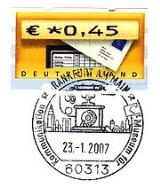
Variable value stamp
Encyclopedia
A variable value stamp, is a gummed or self-adhesive postage stamp
of a common design, issued by a machine similar to an Automatic Teller Machine, with a value of the user's choice printed at the time the stamp is dispensed. The value may be variable or from a fixed selection of postal rates. The stamps and machines are typically for use in retail or post office environments. As only the postal value varies from stamp to stamp, these stamps have been described as key type stamp
s. They are also closely related to meter stamp
s from postage meter
s.
As the concept has developed, a variety of different names have been used, including, but not limited to, Automatenmarken (Germany), ATM stamps (USA), Autopost stamps (USA), Frama labels (Europe) or machine labels (Stanley Gibbons catalogues).
The first patent for a machine to produce variable postage was taken out by Carl Bushe in 1884. In 1900 Christian Kahrs' machine was tested in Oslo. Similar machines were soon tried in Australia, New Zealand and the United States.
Postage stamp
A postage stamp is a small piece of paper that is purchased and displayed on an item of mail as evidence of payment of postage. Typically, stamps are made from special paper, with a national designation and denomination on the face, and a gum adhesive on the reverse side...
of a common design, issued by a machine similar to an Automatic Teller Machine, with a value of the user's choice printed at the time the stamp is dispensed. The value may be variable or from a fixed selection of postal rates. The stamps and machines are typically for use in retail or post office environments. As only the postal value varies from stamp to stamp, these stamps have been described as key type stamp
Key type stamp
Key type stamps are stamps of a uniform design that were widely used by colonial territories in the 19th and 20th centuries.- Origins :The idea was invented by Perkins Bacon who used it to print stamps for Trinidad , Barbados and Mauritius , all featuring the same Britannia design.- Key plate...
s. They are also closely related to meter stamp
Meter stamp
A meter stamp, or meter mark, is the impression made by a postage meter machine that indicates that postage has been paid on a letter or parcel...
s from postage meter
Postage meter
A postage meter is a mechanical device used to create and apply physical evidence of postage to mailed matter. Postage meters are regulated by a country's postal authority; for example, in the United States, the United States Postal Service specifies the rules for the creation, support, and use...
s.
As the concept has developed, a variety of different names have been used, including, but not limited to, Automatenmarken (Germany), ATM stamps (USA), Autopost stamps (USA), Frama labels (Europe) or machine labels (Stanley Gibbons catalogues).
History
There have been many experiments with similar systems over the years but none has been truly successful until the evolution of modern sophisticated computer printing technology. The development of the postage meter, which performs a similar function in businesses and organisations has also been instrumental in developing the technology.The first patent for a machine to produce variable postage was taken out by Carl Bushe in 1884. In 1900 Christian Kahrs' machine was tested in Oslo. Similar machines were soon tried in Australia, New Zealand and the United States.
Frama labels
The Frama company of Switzerland produced a special type of patterned paper suitable for dispensing by machine and electronic printing that could be used to create an unlimited number of different stamp designs. The British Post Office used the paper experimentally in vending machines in 1984-85 but the experiment was not regarded as a success. Frama labels were also introduced in Switzerland in 1976. Frama labels were distinctive for the whole design being printed in one operation onto the special paper, including the value, rather than just the value being printed on to a pre-printed stamp.ATM stamps & Autopost
The U.S. Postal Service experimented with similar stamps in 1989-90. Those experiments also were not considered a success. The U.S. Postal Service owns a patent for an ATM dispensable self-adhesive postage stamp construction.Collecting
ATEEME, the Variable Value Stamps Study and Collecting Group, specializes in collecting these items.Further reading
- Tast, Hans-Jürgen; Abenteuer schreiben - Briefe, Reisen, Automaten (Schellerten 2008) ISBN 978-3-88842-038-2

